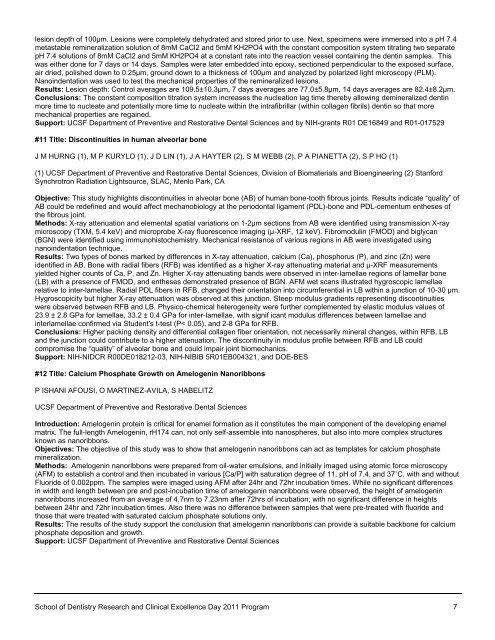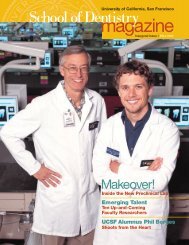Acknowledgements - UCSF School of Dentistry - University of ...
Acknowledgements - UCSF School of Dentistry - University of ...
Acknowledgements - UCSF School of Dentistry - University of ...
You also want an ePaper? Increase the reach of your titles
YUMPU automatically turns print PDFs into web optimized ePapers that Google loves.
lesion depth <strong>of</strong> 100µm. Lesions were completely dehydrated and stored prior to use. Next, specimens were immersed into a pH 7.4<br />
metastable remineralization solution <strong>of</strong> 8mM CaCl2 and 5mM KH2PO4 with the constant composition system titrating two separate<br />
pH 7.4 solutions <strong>of</strong> 8mM CaCl2 and 5mM KH2PO4 at a constant rate into the reaction vessel containing the dentin samples. This<br />
was either done for 7 days or 14 days. Samples were later embedded into epoxy, sectioned perpendicular to the exposed surface,<br />
air dried, polished down to 0.25µm, ground down to a thickness <strong>of</strong> 100µm and analyzed by polarized light microscopy (PLM).<br />
Nanoindentation was used to test the mechanical properties <strong>of</strong> the remineralized lesions.<br />
Results: Lesion depth: Control averages are 109.5±10.3µm, 7 days averages are 77.0±5.8µm, 14 days averages are 82.4±8.2µm.<br />
Conclusions: The constant composition titration system increases the nucleation lag time thereby allowing demineralized dentin<br />
more time to nucleate and potentially more time to nucleate within the intrafibrillar (within collagen fibrils) dentin so that more<br />
mechanical properties are regained.<br />
Support: <strong>UCSF</strong> Department <strong>of</strong> Preventive and Restorative Dental Sciences and by NIH-grants R01 DE16849 and R01-017529<br />
#11 Title: Discontinuities in human alveorlar bone<br />
J M HURNG (1), M P KURYLO (1), J D LIN (1), J A HAYTER (2), S M WEBB (2), P A PIANETTA (2), S P HO (1)<br />
(1) <strong>UCSF</strong> Department <strong>of</strong> Preventive and Restorative Dental Sciences, Division <strong>of</strong> Biomaterials and Bioengineering (2) Stanford<br />
Synchrotron Radiation Lightsource, SLAC, Menlo Park, CA<br />
Objective: This study highlights discontinuities in alveolar bone (AB) <strong>of</strong> human bone-tooth fibrous joints. Results indicate “quality” <strong>of</strong><br />
AB could be redefined and would affect mechanobiology at the periodontal ligament (PDL)-bone and PDL-cementum entheses <strong>of</strong><br />
the fibrous joint.<br />
Methods: X-ray attenuation and elemental spatial variations on 1-2µm sections from AB were identified using transmission X-ray<br />
microscopy (TXM, 5.4 keV) and microprobe X-ray fluorescence imaging (µ-XRF, 12 keV). Fibromodulin (FMOD) and biglycan<br />
(BGN) were identified using immunohistochemistry. Mechanical resistance <strong>of</strong> various regions in AB were investigated using<br />
nanoindentation technique.<br />
Results: Two types <strong>of</strong> bones marked by differences in X-ray attenuation, calcium (Ca), phosphorus (P), and zinc (Zn) were<br />
identified in AB. Bone with radial fibers (RFB) was identified as a higher X-ray attenuating material and µ-XRF measurements<br />
yielded higher counts <strong>of</strong> Ca, P, and Zn. Higher X-ray attenuating bands were observed in inter-lamellae regions <strong>of</strong> lamellar bone<br />
(LB) with a presence <strong>of</strong> FMOD, and entheses demonstrated presence <strong>of</strong> BGN. AFM wet scans illustrated hygroscopic lamellae<br />
relative to inter-lamellae. Radial PDL fibers in RFB, changed their orientation into circumferential in LB within a junction <strong>of</strong> 10-30 µm.<br />
Hygroscopicity but higher X-ray attenuation was observed at this junction. Steep modulus gradients representing discontinuities<br />
were observed between RFB and LB. Physico-chemical heterogeneity were further complemented by elastic modulus values <strong>of</strong><br />
23.9 ± 2.8 GPa for lamellae, 33.2 ± 0.4 GPa for inter-lamellae, with signif icant modulus differences between lamellae and<br />
interlamellae confirmed via Student's t-test (P< 0.05), and 2-8 GPa for RFB.<br />
Conclusions: Higher packing density and differential collagen fiber orientation, not necessarily mineral changes, within RFB, LB<br />
and the junction could contribute to a higher attenuation. The discontinuity in modulus pr<strong>of</strong>ile between RFB and LB could<br />
compromise the “quality” <strong>of</strong> alveolar bone and could impair joint biomechanics.<br />
Support: NIH-NIDCR R00DE018212-03, NIH-NIBIB 5R01EB004321, and DOE-BES<br />
#12 Title: Calcium Phosphate Growth on Amelogenin Nanoribbons<br />
P ISHANI AFOUSI, O MARTINEZ-AVILA, S HABELITZ<br />
<strong>UCSF</strong> Department <strong>of</strong> Preventive and Restorative Dental Sciences<br />
Introduction: Amelogenin protein is critical for enamel formation as it constitutes the main component <strong>of</strong> the developing enamel<br />
matrix. The full-length Amelogenin, rH174 can, not only self-assemble into nanospheres, but also into more complex structures<br />
known as nanoribbons.<br />
Objectives: The objective <strong>of</strong> this study was to show that amelogenin nanoribbons can act as templates for calcium phosphate<br />
mineralization.<br />
Methods: Amelogenin nanoribbons were prepared from oil-water emulsions, and initially imaged using atomic force microscopy<br />
(AFM) to establish a control and then incubated in various [Ca/P] with saturation degree <strong>of</strong> 11, pH <strong>of</strong> 7.4, and 37˚C, with and without<br />
Fluoride <strong>of</strong> 0.002ppm. The samples were imaged using AFM after 24hr and 72hr incubation times. While no significant differences<br />
in width and length between pre and post-incubation time <strong>of</strong> amelogenin nanoribbons were observed, the height <strong>of</strong> amelogenin<br />
nanoribbons increased from an average <strong>of</strong> 4.7nm to 7.23nm after 72hrs <strong>of</strong> incubation; with no significant difference in heights<br />
between 24hr and 72hr incubation times. Also there was no difference between samples that were pre-treated with fluoride and<br />
those that were treated with saturated calcium phosphate solutions only.<br />
Results: The results <strong>of</strong> the study support the conclusion that amelogenin nanoribbons can provide a suitable backbone for calcium<br />
phosphate deposition and growth.<br />
Support: <strong>UCSF</strong> Department <strong>of</strong> Preventive and Restorative Dental Sciences<br />
<strong>School</strong> <strong>of</strong> <strong>Dentistry</strong> Research and Clinical Excellence Day 2011 Program 7




